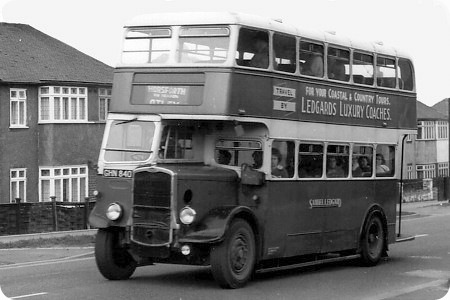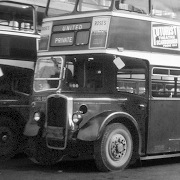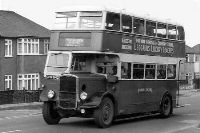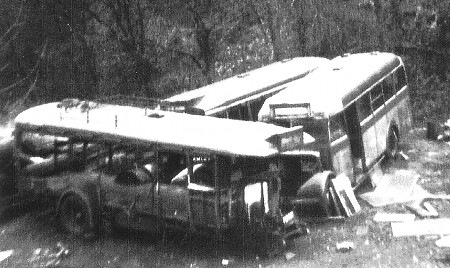Samuel Ledgard – Bristol K6A – GHN 840

Photograph from The late Robert F Mack collection.
Samuel Ledgard
1945
Bristol K6A
ECW L27/26R
As featured in ‘An Arresting Experience’ by Chris Youhill on the ‘articles’ page here we have the vehicle in question. This vehicle was ex-United Automobile Services fleet number BAL 8 new to them in 1945 acquired by Samuel Ledgard in 1959 and served a further six years before being withdrawn from service in 1965.
The Bristol K series was first produced in 1937 and had the high bonnet line as in the shot above until 1946, when the more familiar lower bonnet line was introduced as in the shot to the right.
The above vehicle was one of 251 built after the recommencement of production in 1944 and were the wartime W1 and W2 series all of which had the AEC 7·7 litre six cylinder diesel engine hence the K6A code. As from 1946 the K series was also available with the Gardner 5LW and Bristols first diesel engine the AVW which was a 8·1 litre six cylinder unit. I am not sure what AVW and its successor the BVW stood for, I could guess that the V stood for vertical, if you know please leave a comment. The K series carried on in production until 1950 with over 3000 being built until the one foot longer KS version was introduced.
Photograph contributed by Chris Youhill
Am I right in believing that the difference in bonnet height is the post war "invention" of dropped front axles- and who thought of it first?
Joe
Sorry Joe but, as far as I can glean from publications on the Bristol "K" series, there is no difference at all in the front axles of the low and high radiator "K"s. Dropped front axles were virtually standard on all buses long before WW2. As you say, the apparent dramatic lowering of the radiators and bonnets would suggest some major structural redesign but seemingly not so – the improved appearance must have been achieved by cleverly reducing the clearance above the engine and by a pleasing new radiator design and mountings.
Chris Youhill
As an AEC man, it always struck me that the perfect bonnet line, as aspired to and achieved by London Transport in the RT, was only achieved in the provinces on the post-war Bristols and Guy Arabs.
David Oldfield
And Crossleys, surely?
Peter Williamson
As I signed off the last comment, a Manchester Crossley popped up on a picture and I thought……..and Crossleys!
David Oldfield
There cannot have been any structural difference in the "high" and "low" radiator K chassis, since after the war, many pre-war and wartime utility Bristols were rebodied,and the exercise frequently involved fitting the low radiator to modernize their appearance. Preserved West Yorkshire KDG 26 is a case in point.
David Jones
The ‘low’ radiator is a bit of a trick. The bottom of the working bit of the low radiator is no lower than the high version. If you examine one you will find that the bottom 4 or 5 inches of the low radiator is just decorative. I think I’m right in saying the higher top of the ‘high’ radiator is simply a result of the fact that petrol engines were a lot taller than diesels. When diesels replaced petrol from mid-1930’s there was a lot of fresh air under the bonnet. Hence the line of the bonnet was lowered and with it the top of the radiator.
Bristol’s parts code. The last letter refers to what it is – thus ‘W’ is an engine. The first engine would have been an ‘AW’. In the early 1930’s the ‘JW’ and ‘NW’ were respectively 6-cyl and 4-cyl petrol engines. Once they got to ‘ZW’ then they started again with ‘AAW’ an awful lot of the codes must have been either minor variants or omitted or design studies which were never built. I have no idea how they got as far as ‘AVW’ but that is how the code was arrived at.
Peter Cook
Bristol AVW. the "V" stands for Vertical, and the "W" stands for Water-cooled. The "A" & "B" were the series. AVW’s had dry liners, by far more reliable, and the BVW’s had wet liners, and known for self-destructing, more so when cooled by the diabolical Cave-Brown-Cave system
EE59051
Thanks to the enigmatic EE59051 for his comments. I have a enormous soft spot for Bristol engined Bristols, but it is interesting to note that they seemed to have similar problems to AEC a propos wet liner and dry liner engines.
David Oldfield
Thanks to EE59051 for that very justified comment on the dreadful Cave-Brown-Cave system. In the first place its ugly radiator apertures completely disfigured the vehicles to which it was fitted. More importantly it was absolutely dangerous to drivers in the event of any leakage, especially at full speed, and even at the tiny WYRCC depot at Ilkley there were instances of scalding in the one year that I worked there.
Chris Youhill
I’ve often wondered why companies persevered with the Cave-Brown-Cave system as long as they did, as it never quite seemed to work as the inventor intended. My grandma (a very forgiving soul) would often complain on her family visits, about the freezing cold journeys she had endured from Bingley to Harrogate. The culprits were usually observed to be CBC ‘heated’ Lodekkas. My brother and I would empathise as we often suffered the same discomfort when we visited her, travelling on the same type of bus.
Airlocks seemed to be the main culprit, and could give rise to the strange phenomenon of passengers complaining of how cold their bus was, whilst at the same time said bus was observed boiling away merrily at the front end!
As a West Yorkshire Central Works apprentice, I spent three months working at Grove Park depot, and if a Lodekka was taken out of service as a result of boiling, it was just parked up in the depot and allowed to cool down. It was then topped up with water, whilst someone else worked the engine to try and circulate it around the system. All being well, it would then be deemed ready for action again. The Lodekka water filler cap was still in its original position just above where the traditional radiator would have been. However, as the CBC radiators were set several feet higher on the top deck, many of us thought this to be the cause of the water circulation problems.
Although the BVW engine had its faults – and with hindsight maybe Bristol might have been better staying with dry liners – later versions were generally viewed by West Yorkshire as being decent workhorses. The bottom-end seemed pretty bullet-proof, with many of our examples covering 300,000 miles or more between overhauls, without any crankshaft or bearing problems.
Brendan Smith
Cave-Brown-Cave heating is within my experience, just, but what type of heating was evidenced by a round chrome’y-grill’y protrusion from the front downstairs bulkhead of some buses and coaches and did the system do upstairs, too?
Chris Hebbron
Ah- Memory Lane again: those funny round "heaters" (Clayton Dewandre?- do I imagine that?) on Yorkshire Traction Leylands. Did they ever give off any heat…? Was there a box too under a seat upstairs? They were presumably like the car heaters of the day- a pipe off the cooling system?
Joe
You’re right about the make, Joe. I don’t think that their output was very inspiring, from my limited experience.
Chris Hebbron
The large round heaters with mesh fronts and a chrome "hood" were indeed made by Clayton Dewandre Limited of Titanic Works, Lincoln. They had an electric expulsion fan to blow out the warm air, and warm it certainly was providing that the water circulation was in order, and that the engine was running at a reasonably high temperature. The "boxes under the seats" were usually the excellent and efficient "KL" models, which also had a powerful electric fan. Wiring in both types was usually arranged so that the fans either stopped or slowed while the engines were ticking over at stops. When Samuel Ledgard acquired second hand buses in the later years of the Company it was the practice to install "KL" boxes in both saloons – normally two downstairs and one at the front of the top deck. All of these "retro fitted" heaters were highly efficient and were much appreciated by passengers and conductors alike. In particular I remember the ex Exeter Daimler CVD6/Brush models, where I’ve known passengers plead for them to be turned off in mid Winter – JFJ 55 being the hottest – courtesy of the hot running Daimler engines.
Chris Youhill
Clayton Dewandre indeed, but only for those who sat inside. Sheffield’s first upstairs heating was the horrendously noisy system on 1325 – 1349 (Regent V/Roe).
David Oldfield
I like your ‘inside’ and ‘upstairs’, David. Reminds me when I was young, after the war, there were still a lot of older conductors who shouted at boarding passengers, ‘Plenty of room outside’ even though open-top buses were long gone!
Chris Hebbron
Its an absolute delight reading all these posts about Sammy Ledgard. My memories go back to before Sammy died, and the "exors" were formed. In many ways, this was a more interesting period as the fleet had more "corporate" character, with its "standard" Leylands going way back. This is all in the days before grey came into the livery. Many had Green roofs.
It was certainly an enthusiasts paradise after 1953 with the amazing variety of second hand purchases, but I think my most precious Sammy memory is the Butlers scrapyard just below the "Fox and Hounds" near Menston. In 1953/4, and for some time after, this was full of withdrawn Ledgard buses, some going back to the 1920s. They had been stored at Armley for years, Sammy never disposing of "owt" which might come in useful!
John Whitaker
29/03/11 – 07:35
I am pretty sure that the first Sheffield buses delivered with underseat heaters in the top deck were the ECW bodied PD2s of 1957 (1152/3 and 1292-1294). I recall travelling on the 12 to Chesterfield on one when virtually new and being most disappointed that the noise from the heater drowned out the note of the O.600 engine.
Ian Wild
29/03/11 – 13:22
Significant that they were JOC buses. I never remember them on the 12, nor do I remember 1152/3 without doors. Having never travelled on any of these buses, I bow to your superior knowledge.
David Oldfield
29/03/11 – 13:30
I was most interested in John Whitaker’s nostalgia about the Butler scrapyard at Eller Ghyll, Menston where a large number of Ledgard vehicles were dismantled after years of storage. It was a place where mixed feelings were always aroused – revelling in the range of vehicles which languished there, and yet incredibly sad at the same time.
Here is one of my early snapshots (if only digital had been around !!). The larger vehicle is one of the ex B & B Leyland Lion LT1/Burlingham pair, KW 7944/5. No prizes for identifying the other two buses – they are 40% of the fleet of five heroic little Bedford OWBs which served so valiantly at the Yeadon (Moorfield) depot. It is impossible for those unfamiliar with the territory to imagine how much heavy work those little champions handled on two of the most intense and heavily patronised routes – and of necessity overloading was common which made their performance even more remarkable and creditable. I’ve driven OB coaches myself and never failed to marvel at how these tough little classics performed – unashamedly noisily while "getting up to speed" in the first three gears and then with dignified very quiet tones in "top." I still can’t believe how 28hp petrol engines (many private cars today have greater capacity and technology) could produce such splendid results under heavy pressure. What a crying shame that more souvenirs were not saved from these vehicles as I’m quite sure that Butler’s would have been amenable to the cause. The final sad insult to the little Bedfords was to have to languish there in full view of their successors, as their former lifetime route was less than a hundred yards away on the road above !!
Chris Youhill
30/03/11 – 06:07
1294 and 1295 (the first of the three contemporary Roe bodied PD2/20) were allocated to Leadmill Road Depot hence 1294 turning up frequently on the 12 to Chesterfield. I don’t remember the Roe trio (1295-1297) being delivered with saloon heaters. There was a restricted height bridge at Dronfield on service 12 and not all buses could be used on the Chesterfield service. I suspect the ECW bodies were of slightly lower overall height than the Roe bodies on the similar chassis as I never remember seeing 1295 on the 12 although the standard vehicles for the route at that time were Roe bodied Regent III 1251-1282. Different chassis make, slightly lower build?
Ian Wild
30/03/14 – 12:54
Imagine an engine block in profile and standing next to it a tall radiator. Hot water rising from the engine passes thru a large hose to the top of the radiator. Movement air passing thru the radiator cools the water which slowly sinks returning via the bottom hose to the engine block whence it rises again. This is the simple thermo-syphon system with the of necessity tall radiator which was fitted to most pre-war vehicles. It had many disadvantages. Big improvements were made. At atmospheric pressure water boils off so the cooling system was pressurised to raise the boiling temperature. A cooling fan was fitted to draw air through the radiator even whilst the vehicle was stationary. A thermostat controlled the temperature of the cylinder head. Most importantly, an impeller pump was fitted to increase the cooling water circulation speed thus vastly increasing cooling efficiency. Efficient radiators could be made much smaller and lower. This was a boon to the bodywork designers wishing to offer attractive lower profiles. This is the reason why lower outlines became possible. It has nothing to do with the engine which can be tilted or even, as in the Commer TS3 design, laid flat.
Peter Woods
 Vehicle reminder shot for this posting
Vehicle reminder shot for this posting
05/02/16 – 06:33
Back to radiator height, I believe on the high radiator access for the crank handle was below the radiators bottom tank, whereas on the low radiator everything was lower because it was possible for the shaft of the crank handle to pass between the radiators tubes. This was not a new arrangement as Tilling Stevens B10s of the late 20s had this style of radiator. Bonnet height was often determined by whether air filters were fitted above the engine.
Bob Cooper
Quick links to the - Comments Page - Contact Page - Home Page
Comments - Please note: The comments facility is not currently available. Please see the home page for updates.
Please Note if you want to send a photograph with your comment please use the Contact Page by clicking here or send as an attachment via email.

